Key Elements for Assembling Your Personal Computer


Intro
Building a personal computer is an intricate but rewarding process. This endeavor is not merely about assembling hardware; it requires a clear understanding of various components and how they interact. Each element plays a crucial role in the overall functionality and performance of the system. Therefore, knowledge about specifications, compatibility, and intended use cases is essential.
In this guide, we will dissect the key elements involved in constructing a personal computer. We will explore various hardware components, delve into software considerations, and provide practical advice. This information is tailored for both novices and experienced IT professionals looking to optimize their builds. Understanding these factors can lead to better decisions that meet specific computing needs effectively and efficiently.
Understanding the Basics of PC Construction
Building a personal computer is an intricate but rewarding endeavor. Understanding the fundamentals of PC construction sets the foundation for effective decision-making throughout the entire build process. This knowledge allows you to select components semantically aligned with your personal needs or professional requirements.
The importance of grasping PC construction basics cannot be overstated. It prepares you to navigate the diverse world of hardware and software, helping you to avoid costly mistakes that can arise from a lack of awareness. Knowing which components to prioritize ensures a balanced system. This is critical whether you are gaming, working with large datasets, or simply browsing the internet.
A well-informed builder can discern between flashy marketing and actual performance, resulting in a more efficient, purpose-oriented machine. Factors such as compatibility, power requirements, and the overall ecosystem of selected parts must be considered. Each decision impacts the performance and longevity of your setup.
"Knowledge is power in the realm of PC construction. Understanding your options leads to informed choices."
Defining Your Purpose
Establishing a clear purpose for your personal computer is imperative. Are you aiming for high-end gaming performance, content creation, software development, or everyday use? Your answers will guide nearly every aspect of your build, from selecting the CPU to determining the necessary RAM and storage options.
A dedicated gaming PC, for example, demands a powerful CPU and a dedicated graphics card, like the NVIDIA GeForce RTX series, to handle visually demanding tasks. Conversely, if your primary goal is casual browsing or document work, a lower-end processor with integrated graphics could suffice, ultimately saving you money.
Ultimately, outlinig your objectives allows you to tailor the system uniquely to your lifestyle, enhancing satisfaction and performance.
Setting a Budget
Budgeting is a significant part of building a personal computer and can greatly influence the components you choose. By setting a realistic budget from the outset, you again prevent overspending and can allocate funds more effectively. First, figure out how much you can allocate to the entire build. This should include not just hardware costs, but also software and necessary peripherals, such as monitors, keyboards, and mice.
It often helps to break your budget into categories:
- Core Components: This includes the CPU, motherboard, RAM, storage, and GPU.
- Peripheral Devices: Keep in mind monitors, keyboards, and speakers.
- Software Costs: Operating systems and necessary applications should also be considered.
Evaluating different price points for each component can reveal potential compromises. Like, opting for a slightly less powerful GPU can allow more budget for additional RAM or a higher quality display. Reviewing forums like Reddit or specialized websites can provide insights on performance vs. cost, aiding in making these important decisions.
Core Hardware Components
The core hardware components form the backbone of any personal computer. These elements not only determine the performance of the PC but also influence its flexibility, scalability, and overall capability to meet varied user requirements. When planning your build, understanding the function and compatibility of each component will greatly assist in creating a system that aligns with your specific purposes, be it gaming, content creation, or professional tasks.
Central Processing Unit (CPU)
Choosing Between AMD and Intel
The choice between AMD and Intel is often a pivotal decision when selecting a CPU. AMD Ryzen processors are known for their strong multi-threading capabilities, making them popular among users who run applications that capitalize on many cores, such as video editing software and 3D rendering programs. Conversely, Intel's Core series is often favored for its single-core performance, which is essential for gaming and tasks that require quick processing of information.
A significant factor to consider is price-to-performance ratio. AMD generally offers greater value at lower price points compared to Intel, leading to its growing popularity among budget-conscious builders. However, some may prefer Intel for its robust reliability, especially in power-hungry situations.
Furthermore, thermal management can differ; AMD CPUs tend to run cooler, which can simplify cooling system considerations. Ultimately, the choice depends on user needs, desired applications, and personal budget.
Understanding CPU Performance Metrics
In evaluating CPU performance, metrics such as clock speed (measured in GHz), number of cores, and threading capabilities are fundamental. Clock speed often correlates with how quickly the CPU performs tasks, although it is not the sole determinant of overall efficacy. The number of cores indicates how many processes the CPU can handle concurrently; thus, more cores can lead to improved performance in multi-threaded applications.
Another essential metric is thermal design power (TDP), indicating how much heat a CPU generates. This allows builders to choose appropriate cooling systems. A CPU with high TDP requires advanced coolers that may add to the overall build cost. Understanding these metrics helps in making informed selections that meet performance expectations while balancing cost and efficiency.
Motherboard
Compatibility Considerations
Choosing a motherboard involves ensuring compatibility with the CPU, RAM, and other components. This includes understanding the socket type for the CPU and the supported RAM specifications. Not all motherboards will work seamlessly with every component, necessitating diligence during selection to avoid issues post-assembly.
For instance, older motherboards may not support newer processors. Thus, it is crucial to check the manufacturer's compatibility lists. Additionally, features such as PCIe slots, USB ports, and chipset capabilities can vary widely among motherboards. Emphasizing compatibility will facilitate a smoother building and upgrading process in the future.
Selection of Chipsets
The motherboard chipset determines the features available to the user and its capability to support specific technologies. For example, chipsets like Intel's Z-series allow for overclocking, enhancing performance for enthusiasts. On the other hand, B-series chipsets provide essential features suitable for a basic setup without the need for high-end performance.
When selecting a chipset, consider your future needs. A robust chipset may expand possibilities for upgrades and enhancements later. It prevents being constrained by a motherboard that cannot accommodate desired expansions.
Memory (RAM)
Types of RAM
There are primarily two types of RAM available: DDR4 and DDR5. DDR4 is currently the more common type, while DDR5 is beginning to enter the market. DDR5 offers increased bandwidth and improved efficiency, which might greatly benefit future-proofing your build.
In choosing RAM, compatibility with the motherboard and CPU is essential. Ensure that the type and speed of RAM are supported. Additionally, brands known for reliability often provide better warranties and support, which can be beneficial in the long run.
Assessing Capacity Needs
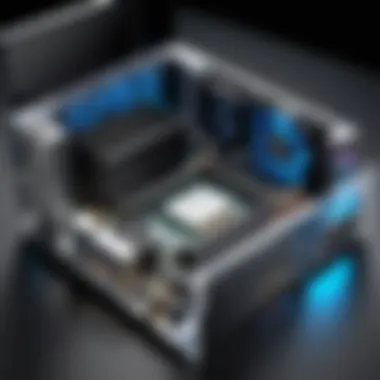
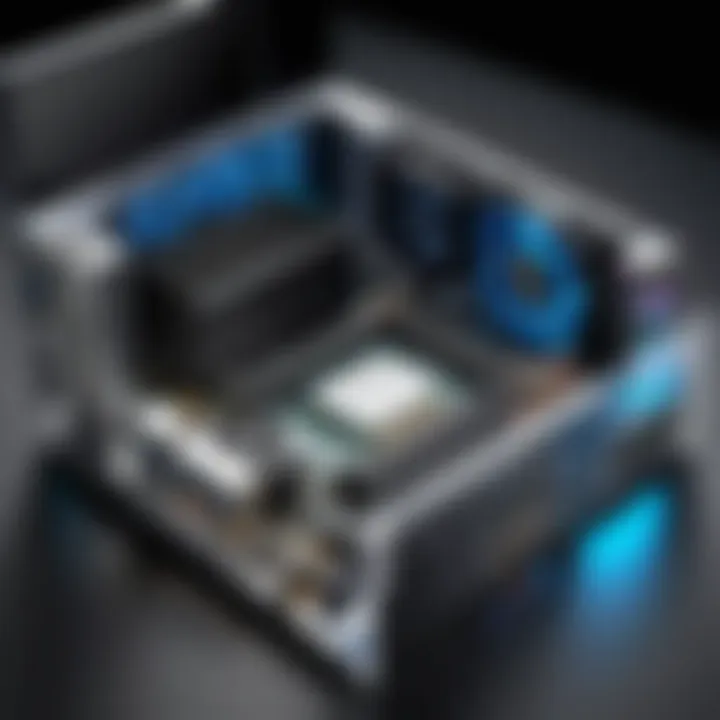
Assessing how much RAM is necessary can depend on your intended use. For general tasks like web browsing and document editing, 8GB may suffice. However, for gaming and demanding applications, 16GB is often recommended. For heavy multitasking or resource-intensive tasks, such as video editing, 32GB or more could be essential.
Considering future needs is critical when choosing RAM capacity. If upgrading is likely, selecting a motherboard that can support additional RAM down the line may be prudent.
Storage Solutions
Hard Disk Drives vs. Solid State Drives
The debate between Hard Disk Drives (HDD) and Solid State Drives (SSD) is significant for building a personal computer. HDDs traditionally offer larger storage capacities at lower prices but tend to be slower. In contrast, SSDs provide rapid load and boot times, enhancing overall system responsiveness.
Many users now opt for a mixed approach, using SSDs for the operating system and frequently used applications while utilizing HDDs for bulk storage. This balance allows for improved performance without sacrificing storage capacity. However, SSDs are generally more expensive on a per-gigabyte basis, which is a crucial consideration for users on a budget.
Understanding Storage Speed and Capacity
Storage speed is measured in read and write speeds, which are essential in determining how quickly data can be accessed. SATA SSDs are commonly used, but NVMe drives provide significantly higher speeds due to their direct connection to the motherboard.
Capacity needs should also factor into your choice. General users may find 500GB to 1TB sufficient, while gamers and content creators often require 2TB or more. Assessing your storage requirements will inform your choice between HDDs and SSDs, ensuring efficient performance aligned with your needs.
Graphics Processing Unit (GPU)
Integrated vs. Dedicated Graphics
The choice between integrated and dedicated GPUs can greatly influence system performance, particularly for gaming or graphic-intensive applications. Integrated graphics are built into the CPU and are suitable for everyday tasks and light gaming. However, they lack the power of dedicated cards, which are more capable of handling intensive graphical demands, such as real-time rendering and processing high-resolution textures.
For most gaming and graphical creation purposes, a dedicated GPU is necessary to deliver satisfactory performance. It allows for higher frame rates and better quality settings in modern games or software applications.
Evaluating GPU Performance
When assessing GPU performance, metrics such as VRAM (Video RAM), core count, and boost clock speed are critical. VRAM is essential for high-resolution textures; thus, more VRAM is advantageous for gaming or design work. Additionally, examining benchmark results can provide valuable insights into real-world performance, as these reflect how a GPU will perform in actual scenarios.
Choosing a GPU that matches your workload requirements ensures optimal performance without overspending on unnecessary capabilities.
Power Supply Unit (PSU)
Selecting the Right Wattage
A power supply unit (PSU) is fundamental for ensuring that all components receive adequate power. Selecting the right wattage is vital; underestimating power needs can result in performance issues or damage to hardware. Online calculators can help determine the necessary wattage based on the specific components chosen.
A good rule of thumb is to allow for some headroom above the calculated need, particularly if planning to overclock or add components later.
Efficiency Ratings Explained
Efficiency ratings indicate how effectively a PSU converts AC power to DC power. An 80 Plus certification, for instance, ensures that at least 80% of the energy is used effectively, reducing waste and operating costs over time. Higher efficiency ratings often result in quieter operation and lower heat output, extending the lifespan of the PSU and other components.
Choosing an efficient PSU not only supports stability in your system but can also lead to significant capital savings regarding energy consumption.
Computer Case
Form Factors and Compatibility
The computer case houses all your components and should have the right form factor, such as ATX, Micro ATX, or Mini ITX, compatible with the motherboard size. Good compatibility ensures easy assembly and sufficient space for cable management and airflow.
Providing options for expansion slots and drive bays also contributes to a better user experience, allowing for future upgrades without requiring a new case.
Importance of Airflow and Cooling
Airflow is critical for performance and longevity. A case with good airflow design will help keep temperatures down, especially when under load. Proper cooling can prevent thermal throttling, which can hinder performance and damage components over time.
Additionally, considering fan configurations and the potential for liquid cooling solutions can further enhance cooling efficiency. An effectively cooled computer will run reliably and extend the lifespan of internal components.
A well-thought-out selection of core components is essential for achieving an efficient and powerful personal computer, paving the way for a rewarding user experience.
Peripherals and Accessories
In the quest to build an efficient personal computer, peripherals and accessories play a crucial role. These components enhance user experience, determine functionality, and cater to specific needs. Investing in quality peripherals ensures that the computer operates optimally, improving productivity and enjoyment during use. A well-chosen keyboard, mouse, and monitor can significantly impact daily tasks, whether for professional work or gaming.
Display Options
Types of Monitors
The choice of monitor is essential when assembling a computer. There are several types of monitors available today. The three most common categories are:
- LCD (Liquid Crystal Display): Known for their energy efficiency and slim profiles, LCDs are a popular choice for general use. They deliver good quality images with reasonable color accuracy.
- LED (Light Emitting Diode): A subset of LCD, LED monitors offer better brightness and contrast. They are also more energy-efficient, making them preferred for high-end applications.
- OLED (Organic Light Emitting Diode): These monitors provide superior color reproduction and true blacks due to individual pixel illumination. However, they usually come with a higher price tag.
Each type comes with its unique attributes, catering to varying needs, from everyday tasks to graphic design. The key characteristic of modern monitors is their adaptability to different resolutions, which impacts clarity and visual fidelity.
Resolution and Refresh Rate Considerations
When selecting a monitor, resolution and refresh rate are vital factors. Resolution determines the clarity of the image displayed. Popular resolutions include:
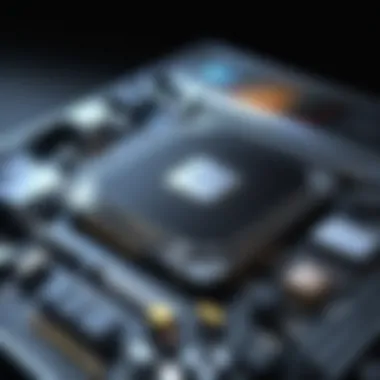
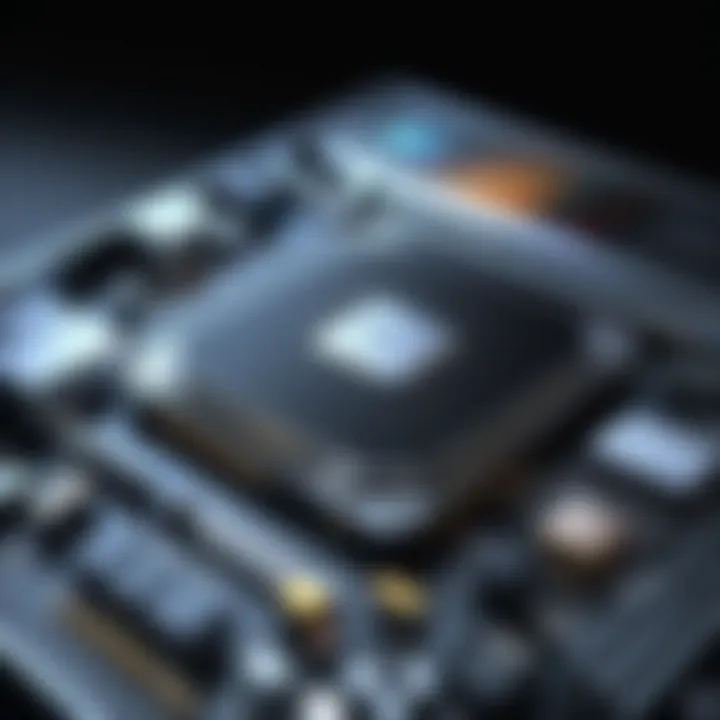
- 1080p (Full HD): Common for standard tasks and gaming.
- 1440p (Quad HD): Offers greater detail, suitable for gaming and professional use.
- 4K (Ultra HD): Provides the sharpest image for creative work.
The refresh rate, measured in Hertz (Hz), indicates how many times the image refreshes per second. Higher refresh rates, like 144Hz or 240Hz, are preferred for gaming as they reduce motion blur. A unique advantage of achieving a balance between both factors directly contributes to overall user satisfaction and performance efficacy.
Input Devices
Selecting Keyboards and Mice
Input devices form the primary interface between the user and the computer. Keyboards and mice come in various styles and functionalities. Mechanical keyboards, for instance, are favored by gamers because they offer tactile feedback. In contrast, membrane keyboards are quieter and more suitable for office settings.
Mice also vary in type. Optical and laser mice both provide precise tracking, but laser can work on more surfaces. When selecting these devices, consider what type of tasks you will engage in and choose accordingly. Their unique features contribute directly to performance, making them vital in the selection of peripherals.
Ergonomics in Peripheral Choices
Ergonomics is a significant but often overlooked aspect of peripheral selection. Well-designed keyboards and mice can reduce strain on the body during prolonged use. Ergonomic keyboards are typically split or curved to promote a natural wrist position. Mice designed with ergonomic principles can improve comfort and reduce the risk of repetitive strain injuries.
The core advantage of investing in ergonomic peripherals lies in long-term health benefits. Users can avoid discomfort and potential injuries, enhancing their overall computing experience. Therefore, careful ergonomic consideration is vital when making peripheral choices.
"Selecting the right peripherals not only enhances performance but also elevates the overall computing experience. An informed choice leads to higher satisfaction and productivity."
In summary, peripherals and accessories are more than just add-ons; they are essential for maximizing the functionality of your personal computer. Understanding display options and input devices, along with their unique features, is critical in creating an efficient computing environment.
Software Requirements
In the process of building a personal computer, the selection and installation of software are just as critical as choosing the right hardware components. Software requirements shape the user experience, supporting the applications and functionalities desired from the computer. Understanding software types and licensing implications becomes essential, as many users may not realize the impact these choices have on performance and usability. Therefore, a careful evaluation of software needs is vital to meet individual use cases effectively.
Operating System Selection
Comparative Analysis of OS Options
When selecting an operating system (OS), a comparative analysis of different options becomes crucial. The most common choices include Microsoft Windows, macOS, and various distributions of Linux. Each OS offers distinct features that cater to different needs.
- Microsoft Windows is versatile and widely supported. Its key characteristic is a broad range of application compatibility, especially for gaming and productivity software. This makes it a popular choice for many users seeking extensive functionality.
- macOS is known for its smooth user interface and stability. Its unique feature lies in its optimized performance on Apple hardware. However, the limited compatibility with software and hardware outside the Apple ecosystem can be a disadvantage for some users.
- Linux, boasting various distributions, is favored for its open-source nature and customization capabilities. Its strengths come from flexibility and security. Still, the learning curve can be steep for those unfamiliar with command lines and Linux commands.
These analyses provide insights into the best operating system choice based on individual preferences and requirements, ultimately enhancing the overall performance of the personal computer.
Software Compatibility Considerations
Software compatibility is a fundamental aspect of the operating system selection. Ensuring that chosen applications and utilities can run smoothly on the installed OS is pivotal for a seamless experience. A key characteristic of software compatibility considerations is the analysis of software requirements and dependencies.
For instance, certain software applications, particularly those used for productivity, may only be available on specific operating systems. This makes it crucial to verify compatibility prior to the installation of any OS. Choosing an OS with broad application support can save the user from potential conflicts post-build.
Moreover, many applications might release updates that require newer OS versions. Thus, understanding the compatibility landscape not only informs the current setup but also protects the investment for the future. A key disadvantage is that some popular software may not offer support for specific OS, leading to frustration for users who prefer alternatives.
Application Software
Essential Software for Different Use Cases
The selection of application software often depends on the intended use of the personal computer. Users may require software for various purposes such as gaming, graphic design, coding, or general productivity tasks. Identifying essential software tailored to these use cases is critical.
For example, if a user intends to play resource-intensive games, they will need to install a reliable game launcher and possibly additional monitoring tools to optimize performance. Conversely, a graphic designer may require software like Adobe Photoshop or CorelDRAW. The diversity in software options and their unique features emphasizes the importance of aligning software choices with specific computing needs.
Moreover, understanding these needs at the outset can save time and headaches during system deployment. It allows users to plan for the necessary resources and installation processes that will support their workflows thereafter.
Licensing and Cost Implications
Licensing and cost implications can significantly affect the overall investment in a personal computer. Different software solutions offer various licensing models such as subscriptions, perpetual licenses, or free trials. Understanding these models can assist users in making informed financial decisions.
For example, subscription services like Microsoft 365 allow flexibility but incur ongoing costs, whereas a one-time purchase for software like AutoCAD may seem expensive upfront but offers long-term usage. A key characteristic of this consideration is weighing the recurring versus one-time costs and their subsequent impact on the budget.
Additionally, open-source software presents an economical alternative while still providing robust features. However, some proprietary software offers superior support and functionality that may justify the cost. Evaluating these aspects ensures that users make prudent decisions that suit their financial situation while meeting their software needs.
Assembly Process
The assembly process stands as a crucial stage in the journey of building a personal computer. It is the phase where all the prior planning and selection of components materializes into a functioning unit. Understanding the steps involved is vital for both novice builders and experienced professionals. A methodical approach ensures that each component is integrated properly, reducing the risk of malfunctions and enhancing the performance of the final machine. The assembly process not only empowers builders to customize their systems but also fosters a deeper appreciation of how each hardware part contributes to overall computing capabilities.
Preparing Your Workspace
Before diving into the assembly, taking time to prepare an organized workspace is essential. A clean and spacious area minimizes the chance of losing components and helps prevent damage.
Safety Considerations
Safety should be a priority when assembling a PC. This involves grounding oneself to prevent static electricity, which can damage delicate components. Utilizing an anti-static wrist strap is a good practice. Additionally, ensuring all tools and parts are within reach avoids unnecessary movements that could lead to spills or accidents. The key characteristic of safety considerations lies in protecting the hardware investment. By emphasizing safety, builders can avoid costly mistakes and guarantee a smoother assembly experience. This conscious focus on safety is beneficial for all, especially those unfamiliar with handling electronic components.
Essential Tools for Assembly
Equipped with the right tools can elevate the assembly process significantly. Standard tools like screwdrivers, pliers, and anti-static wrist straps are imperative. Each tool serves a specific purpose that aids in making the build efficient and secure. The unique feature of having essential tools is that they streamline the assembly. For instance, a magnetic screwdriver makes handling screws much easier and reduces the risk of dropping them. This consideration can save time and stress during assembly.
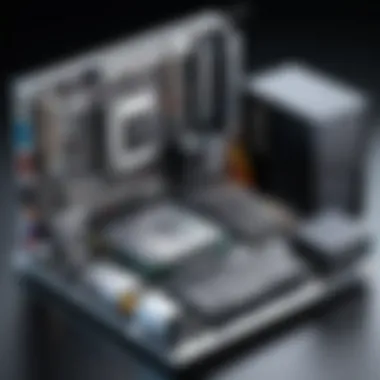
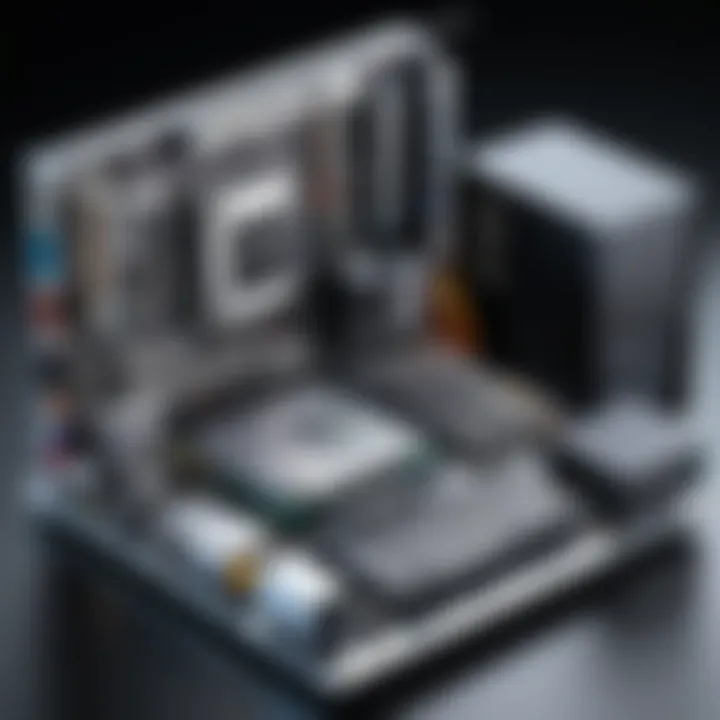
Step-by-Step Assembly Guide
Following a systematic guide helps demystify the assembly process. Each step, though distinct, connects and contributes to the completion of the build.
Installing CPU and RAM
Installing the CPU and RAM is a foundational step in the assembly. This step requires careful alignment of the CPU with the socket on the motherboard, ensuring secure attachment with the locking mechanism. Similarly, RAM must be properly seated in the slots. The beneficial aspect of this installation is that it sets the stage for all other components and influences system performance directly. A proper installation minimizes boot issues and enhances system responsiveness.
Mounting the Motherboard
Mounting the motherboard requires securing it within the computer case carefully. Using standoffs prevents it from touching the case, avoiding potential short circuits. The critical characteristic of this action is its fundamental role in system stability and component compatibility. Ensuring correct alignment of ports with the case's back panel is necessary for future connections, further enhancing usability.
Connecting Power Supply and Cables
Connecting the power supply and cables is essential for providing energy to the system. This involves attaching the main power connectors to the motherboard, as well as connecting cables for components like the GPU and storage drives. The emphasis here is on organization; managing the cables properly leads to better airflow within the case. A clean setup simplifies future upgrades and maintenance.
Installing Storage and GPU
The installation of storage drives and the GPU comes at a stage when all main components are in place. Mounting these parts correctly not only impacts performance but also influences the build aesthetics. The unique feature of installing a GPU, for instance, lies in the attention to detail required in securing it in the PCIe slot and connecting any necessary power cables. It is often regarded as a check on performance aspirations—selecting the right GPU can power up gaming and graphic-intensive tasks.
Initial Testing
Testing the assembly ensures that everything is functioning properly before the first use. It is a critical step to validate the work done and reveal any misconfigurations or hardware issues.
Power-On Self-Test (POST)
The Power-On Self-Test, or POST, occurs when the computer is powered on for the first time. During this process, the motherboard checks the integrity of the components. Any errors will typically be indicated through beep codes or messages on the screen. Understanding POST is invaluable; it provides immediate feedback on the health of the assembly. A successful POST means the assembly is on the right track, whereas issues here may indicate a need for troubleshooting.
BIOS Configuration Recommendations
Configuring the BIOS is often an overlooked aspect but is critical for optimal performance. It allows users to tweak settings like boot order, system time, and hardware parameters. Familiarizing oneself with BIOS options can significantly enhance system performance. Since each motherboard might have peculiarities, the key aspect of BIOS recommendations involves following the manufacturer’s instructions. Proper configuration sets the tone for the operating system and further ensures stability and performance efficiency.
Ensure to review BIOS settings after the initial build to optimize performance.
This assembly process gives builders a robust framework to create their personal computer. Understanding each step and its implications can make the difference between a successful build and a disappointing experience.
Troubleshooting Common Issues
When building a personal computer, one might experience various issues that arise during assembly or operation. Understanding how to troubleshoot common problems is crucial to ensure smooth performance. This section addresses the significance of troubleshooting, highlighting key elements like identifying the cause of an issue, implementing effective solutions, and preventing future problems. Proper troubleshooting minimizes downtime and enhances the overall experience.
Diagnosing Boot Problems
Boot problems can manifest in several ways, from failure to power on to hang-ups during the startup process. Diagnosing these issues involves several steps:
- Check Power Supply: Ensure that all power connections are secure. Faulty power supplies may prevent the PC from booting up, leading to possible confusion about other components.
- Examine Beep Codes: Many motherboards emit beep codes during the boot process. Understanding these codes can help pinpoint issues related to RAM, CPU, or graphics cards.
- Inspect Display Output: Sometimes, the issue is not with the system itself but with the monitor. Check if the display is working by using an alternative connection or another monitor.
- Reset Components: Reseating RAM and GPU can sometimes resolve boot issues. This action also ensures that the components are properly connected.
To facilitate a better understanding, here are some common boot problems:
- No power detected: Often related to power connections.
- Stuck on BIOS screen: Could indicate compatibility issues or faulty hardware.
- Repeated reboot cycles: Often linked to problems with RAM or the operating system.
"> Nascent issues are often elusive, but systematic troubleshooting can illuminate paths to resolution. "
Resolving Hardware Conflicts
Hardware conflicts often arise when two or more components interfere with each other’s operation. Addressing conflicts is essential for ensuring stable performance. Here are several steps to resolve these issues:
- Check Device Manager: For Windows users, the Device Manager provides insights into conflicts. Look for devices marked with a yellow triangle.
- Update Drivers: Ensuring that all drivers are up-to-date can often prevent conflicts.
- Reseat Components: Sometimes, physically removing and then re-inserting components can help to mitigate conflicts.
- Review BIOS Settings: Occasionally, BIOS may require adjustments to accommodate specific hardware configurations.
Be vigilant about symptom recognition. Some signs of hardware conflicts include:
- Blue Screen of Death (BSOD): Often linked to driver issues or hardware incompatibility.
- Random freezes or crashes: May indicate underlying hardware conflicts.
- Peripheral malfunction: Issues with peripherals could signal conflicts with installed drivers or resource allocation.
In summary, keeping a keen eye on potential issues during the PC building process can significantly enhance one’s experience and keep frustration at bay. Identifying and resolving boot problems along with addressing hardware conflicts form essential skills for effective PC maintenance.
Maintenance and Upgrades
Maintaining and upgrading a personal computer is vital for ensuring long-term performance and extending the lifespan of the system. Regular maintenance can prevent common hardware failures, while strategic upgrades can keep the PC aligned with evolving software requirements. By engaging in proper upkeep and timely enhancements, users can save money in the long run and improve their computing experience significantly.
Routine Maintenance Tips
Routine maintenance involves regular checks and updates to optimize your system. Here are several essential practices:
- Dusting and Cleaning: Keep the interior of your computer clear of dust and debris. Dust can accumulate on components, leading to overheating issues. Use a can of compressed air to clean the fans and heatsinks monthly.
- Checking Cables: Ensure all cables are secure and free from wear. Loose or frayed cables can cause power interruptions or performance issues.
- Software Updates: Keeping your operating system, drivers, and applications updated ensures security improvements and optimal performance. Set a schedule for regular checks.
- Disk Cleanup: Utilize built-in tools to remove unnecessary files from your storage devices. This improves system responsiveness and creates space for new applications.
- Defragmentation: If using traditional Hard Disk Drives (HDDs), perform regular disk defragmentation. This reorganizes fragmented data, improving access time.
Regular maintenance is not just about fixing issues; it's about creating a proactive environment for your computer that preempts problems.
Evaluating Upgrade Paths
When considering upgrades, it is crucial to assess what components would most benefit your current setup. Here are key aspects to consider:
- Assess Your Needs: Are you gaming, video editing, or simply browsing? Identify what tasks could benefit from hardware enhancements.
- Budgeting for Upgrades: Determine how much you are willing to invest in upgrades. High-end graphics cards like NVIDIA GeForce RTX 3080 can significantly enhance gaming experience but can be expensive.
- Compatibility: Before purchasing, verify that the new components are compatible with your existing hardware. Websites like PCPartPicker can help you check compatibility.
- Performance Bottlenecks: Analyze your current system performance metrics through tools like CPU-Z or HWMonitor to identify bottlenecks.
- Future-Proofing: Consider future technology trends and select components that will not become obsolete quickly. For example, opting for a motherboard that supports future RAM upgrades is a thoughtful approach.
Upgrading a PC is an art, blending planning, budgeting, and tech knowledge. Making informed choices elevates your computing experience and prepares your system for future demands.
Remember: It’s easier and more cost-effective to maintain your system well than to deal with catastrophic failures later.



